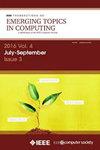3D Invisible Cloak: A Robust Person Stealth Attack Against Object Detector in Complex 3D Physical Scenarios
IF 5.4
2区 计算机科学
Q1 COMPUTER SCIENCE, INFORMATION SYSTEMS
IEEE Transactions on Emerging Topics in Computing
Pub Date : 2024-12-13
DOI:10.1109/TETC.2024.3513392
引用次数: 0
Abstract
In this article, we propose a novel physical stealth attack against the person detectors in real world. For the first time, we consider the impacts of those complex and challenging 3D physical constraints (e.g., radian, wrinkle, occlusion, angle, etc.) on person stealth attacks, and propose 3D transformations to generate robust 3D invisible cloak. We launch the person stealth attacks in 3D physical space instead of 2D plane by printing the adversarial patches on real clothes. Anyone wearing the cloak can evade the detection of person detectors and achieve stealth under challenging and complex 3D physical scenarios. Experimental results in various indoor and outdoor physical scenarios show that, the proposed person stealth attack method is robust and effective even under those complex and challenging physical conditions, such as the cloak is wrinkled, obscured, curved, and from different/large angles. The attack success rate of the generated adversarial patch in digital domain (Inria dataset) is 86.56% against YOLO v2 and 80.32% against YOLO v5, while the static and dynamic stealth attack success rates of the generated 3D invisible cloak in physical world are 100%, 77% against YOLO v2 and 100%, 83.95% against YOLO v5, respectively, which are significantly better than state-of-the-art works.三维隐形斗篷:复杂三维物理场景中针对目标探测器的鲁棒人隐身攻击
在本文中,我们提出了一种新的针对现实世界中人检测器的物理隐身攻击。我们首次考虑了这些复杂且具有挑战性的3D物理约束(例如弧度,皱纹,遮挡,角度等)对人隐身攻击的影响,并提出了3D变换来生成鲁棒的3D隐形斗篷。我们通过在真实的衣服上打印对抗补丁,在三维物理空间而不是二维平面上发动人体隐身攻击。任何人穿着斗篷都可以避开人体探测器的检测,在具有挑战性和复杂的3D物理场景下实现隐身。在室内和室外各种物理场景下的实验结果表明,即使在斗篷皱褶、遮挡、弯曲、不同/大角度等复杂且具有挑战性的物理条件下,所提出的人隐身攻击方法也具有鲁棒性和有效性。生成的对抗补丁在数字域(Inria数据集)对YOLO v2和YOLO v5的攻击成功率分别为86.56%和80.32%,而生成的三维隐形斗篷在物理世界中对YOLO v2和YOLO v5的静态和动态隐身攻击成功率分别为100%和77%和100% 83.95%,明显优于目前的研究成果。
本文章由计算机程序翻译,如有差异,请以英文原文为准。
求助全文
约1分钟内获得全文
求助全文
来源期刊

IEEE Transactions on Emerging Topics in Computing
Computer Science-Computer Science (miscellaneous)
CiteScore
12.10
自引率
5.10%
发文量
113
期刊介绍:
IEEE Transactions on Emerging Topics in Computing publishes papers on emerging aspects of computer science, computing technology, and computing applications not currently covered by other IEEE Computer Society Transactions. Some examples of emerging topics in computing include: IT for Green, Synthetic and organic computing structures and systems, Advanced analytics, Social/occupational computing, Location-based/client computer systems, Morphic computer design, Electronic game systems, & Health-care IT.
 求助内容:
求助内容: 应助结果提醒方式:
应助结果提醒方式:


